Emotions in Historical Documents
This post first appeared on the blog for the Centre for Privacy Studies: https://privacy.hypotheses.org/395

La conduite des filles de joie à la Salpêtrière : le passage près de la porte Saint-Bernard
Étienne Jeaurat (1699 - 1789)
"Jurors do not and cannot detect remorse or any other emotion in anybody, ever. Neither can I and neither can you. And that's because emotions are not what we think they are." This straightforward statement introduces the TED talk You Aren't at the Mercy of your Emotions--Your Brain Creates Them, by Lisa Feldman Barrett, neuroscientist, psychologist, and professor at Northwestern University (and one of my nerdy heroes!)
I first got to know Barrett's work back in 2017 when I read How Emotions Are Made (a book that covers the TED talk topics in more detail). I picked up her book after reading Patricia Churchland’s Braintrust and A.D. (Bud) Craig’s How do You Feel?. Having been captivated for years by the study of emotions—as an actor, as a historian, and as a person who feels them—I had been in a personal and professional quest to understand the role of our neurobiology in our emotions.
Barrett is referring to the trial and conviction of Dzhokhar Tsarnaev, responsible for the Boston Marathon bombings of 2013. The final verdict gave Tsarnaev the death sentence rather than life in prison, in part because the jurors did not think that he felt remorse for killing and hurting so many people. The New York Times reports that “Only two jurors believed that Mr. Tsarnaev had expressed sorrow and remorse for his actions” while “Sister Helen Prejean, a Roman Catholic nun and renowned death penalty opponent, [believed] that he was 'genuinely sorry' for what he had done.” Jurors interpreted Tsarnaev’s emotional expression in one way, a catholic nun interpreted it in a diametrically opposed way.
Who is right?
Well, according to Barrett, both and none. This is because emotions are not an independent reality that exists outside of the brain of the interpreter: an observer's brain creates the emotion that the observer thinks comes from the person being observed. In this context, the jurors—weighted down by the responsibility of granting someone the right to live or die—brought their own emotional baggage into their interpretation of Tsarnaev’s emotions, and a majority of them interpreted him as being remorseless. Helen Prejean, a leading humanitarian who has been fighting for the abolition of the death penalty for years, also brought her own baggage into her interpretation, judging the accused as experiencing remorse. The bottom line: it is impossible to disentangle someone’s emotional expression from the observer's interpretation of that expression. Emotion is co-created by observer and observed. After learning about these insights by Barrett and her team, I started to think of historical documents in a different way...
Take the example of women accused of prostitution in old regime France. They were incarcerated at the Salpetrière in order to mend their morals and atone for their sins. In order to be deemed worthy of eventually being released, a woman had to show signs of true contrition during her long stay at the hospital. Her freedom depended on signs of sincere conversion, and her continued incarceration was justified by signs of pretense. But of course, it was not easy to distinguish sincere repentance from pretended repentance!
Consider the case of the sisters Jeanne and Madelaine Thibault, discussed by Philip F. Riley in A Lust for Virtue. They had been incarcerated at the Salpetrière in 1698 “for having committed the double sin of prostitution with priests and then the sin of sacrilege by receiving the sacraments to mask their evil commerce.” (p. 58) Madeleine was freed after 4 years, but her sister Jeanne had to stay for 10 years before she was released in 1708. Riley notes that Jeanne’s wardens were quite suspicious of her behavior, and in 1705, they attested that her good behavior was due to her having learned of her father’s death, and not due to true repentance for her sins. I am left to wonder how the wardens' own ideas about each sister might have influenced their interpretation of sincerity or pretense.
Now we know from Barrett that it is hard—actually, impossible—to unambiguously detect remorse in someone’s face. In the case of remorse in historical documents, there is an added layer of camouflage: the words of the scribe. For a historian interested in people of lower social rankings, who very rarely left accounts written by themselves, this insight it an eye opener. Indirect sources on poor people’s lives are all that I have to work with, but I have to be extremely sensitive to what I infer based on these indirect, and often unsympathetic, written accounts.

Comentários